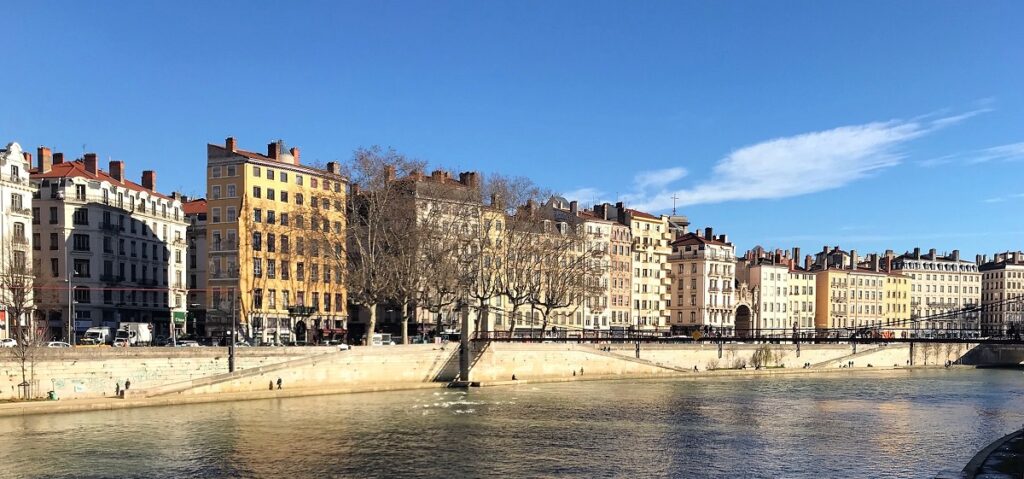Self-guided tour of Old Lyon town and its mysterious traboules
We have prepared for you below an itinerary for visiting the famous traboules and Renaissance courtyards that you can do alone in 1h30 to 2h, alone, as a couple, with your family or in a group.
“Traboules” definition: the old French word “traboules” refers to secret passages between streets, through Renaissance houses and courtyards.
Would you prefer a guided tour?
Enter your request here:
The Old Lyon town, from the 4th century to today
At the end of the Gallo-Roman period, in the 4th century, Lugdunum at the top of the hill of Fourvière was abandoned, its inhabitants settled on the banks of the Saône and the bishopric of Saint-Jean was the new center of Lyon. An episcopal complex develops around, its chamarriers hold the keys of its doors which they close every night. Comes the 16th century, the golden age of Lyon. Drawing what is now called “Old Lyon” town. These are the Italian wars, the arrival of the Renaissance in France, Lyon is the gateway. Large European fairs four times a year, Lombard, Flemish and Champagne merchants. Seventy banks. The population doubled, reaching 20,000 souls, hence this tight habitat like a surprise bread. The wars of religion tumble, Catholics and Protestants kill each other, everything is swept away in twenty years.
In 1998, the whole of the Vieux Lyon district was listed by UNESCO as an International Heritage Site. Old Lyon town is now well restored, in Florentine ocher tones. Its cobbled streets, traboules and courtyards restored to their former glory, with architectural gems from the early Renaissance. We feel here in Italy.
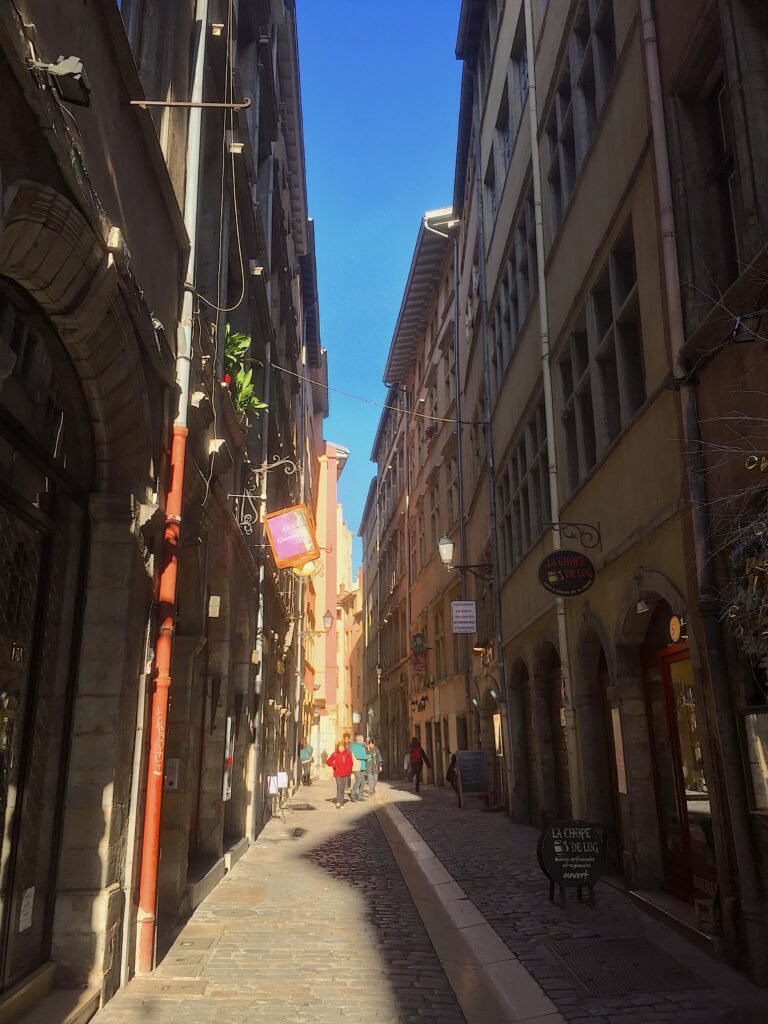
Your tour on the map
Saint-Jean Cathedral
Departing from Saint-Jean Square, you can spend time in the cathedral at the heart of Old Lyon. Its astronomical clock is one of the oldest in Europe (1383, at least) and will give you the exact time until 2019… Why? We would be happy to explain it to you during one of our guided tours. It chimes several times a day with a procession of characters. The ENS Lyon has devoted a very detailed scientific page to it.
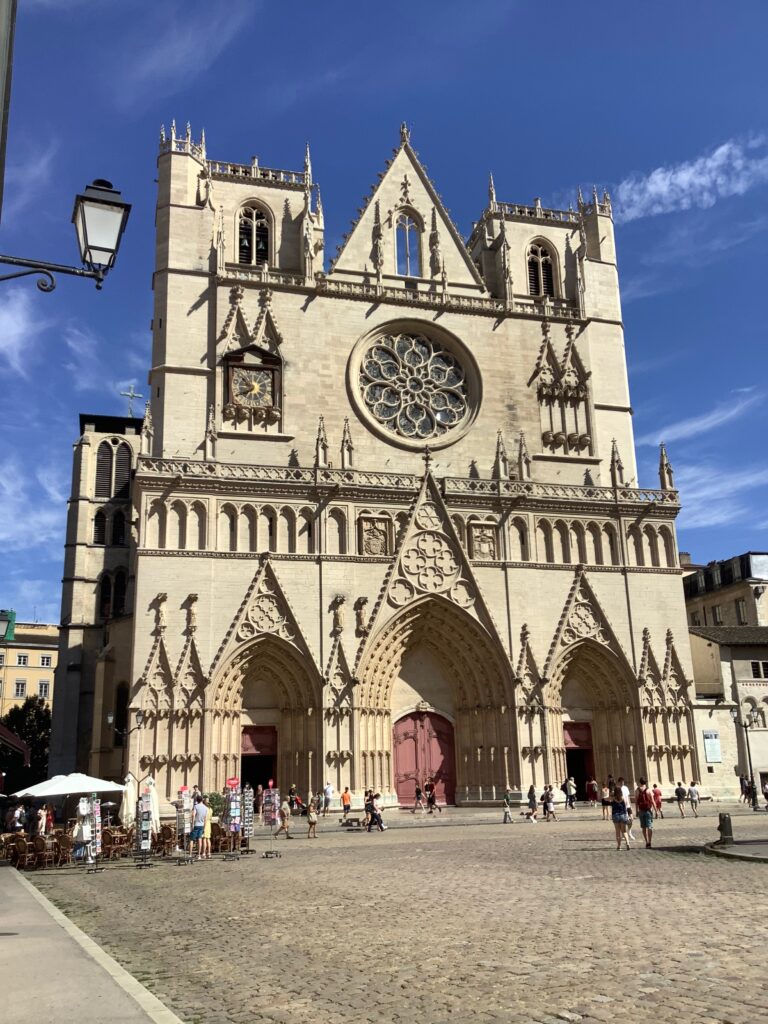
This cathedral was actually a primatial church, as the head of the French church was long the Archbishop of Lyon, the Primate of the Gauls. Religious power counted here. Archaeological excavations have uncovered the traces of three attached religious buildings dating back in part to the 4th century. Adjacent to the cathedral and housing its treasure is what is probably the oldest building in the neighborhood (partly from the 11th century), the Manécanterie.
If you stay at the Youth Hostel above Saint-Jean, you will have the chance to admire the light on this cathedral. It is sublime at sunrise. As at sunset. This sunset that gives a warm light inside through the 12 meters in diameter stained glass of its West Rose.
The Saint-Jean Square, which has (finally) been cleared of cars, has a beautiful fountain in its center where you can find interesting photo subjects. It is also an alternative to the Louis XIV statue in Bellecour Square for some appointments.
The neighborhood has a history of over a thousand years. It almost disappeared after the Second World War when a Lyon mayor wanted to establish marinas on the banks of the Saône. Fortunately, resident associations relayed by Malraux were able to stop it. The site is now classified as a UNESCO World Heritage Site, and as you will see during your visit, attracts many tourists and visitors… including you, we hope, because it is a magnificent neighborhood where you can feel what Lyon was like during the medieval fairs.
Take the Saint-Jean Street.
Maison du Chamarier
Access: 37 rue Saint-Jean
Next stop on the right is a sublime courtyard that has just been restored. It is the “Maison du Chamarier” where a famous pastry shop is located on the corner of the street. Spend some time in this courtyard, soak up its beauty. Imagine yourself in the 17th century when Madame de Sévigné used to come here.
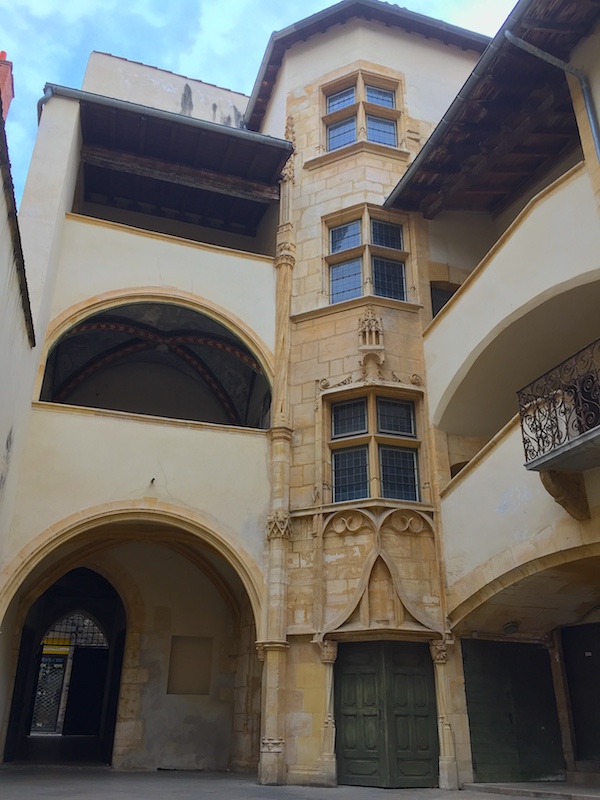
The well is said to have been designed by Philibert Delorme, who had just returned from Italy at the age of twenty-six. We’ll see Philibert again later. This well is ideal for a selfie or group photo.
Maison des Avocats (Lawyers house)
Access: 6 Rue de la Bombarde
In front of you, at the end of a square named Place de la Basoche, a Tuscan-style gallery connects several buildings. The restoration of the Order of Lawyers has given it beautiful colors. The part of the building facing Saint-Jean Street was built in the first half of the 14th century. It was then the “Ostel de la Croys” inn, frequented in particular by jurists. They still occupy the building today with their training center. From 1406 to 2002, the Confrérie de la Basoche was located here.
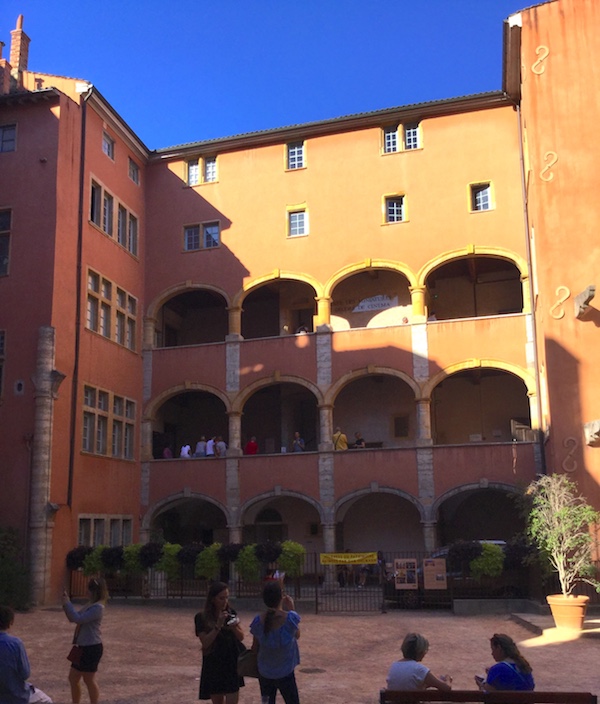
La Basoche
In the Middle Ages, this confraternity brought together jurists, defended their interests, and organized their training, in which theater played an important role. In the farces and sotties that they publicly performed behind masks, the satire of the powerful and customs, anticlericalism, and a certain materialism played an important role, so much so that they were banned in 1540. The confraternity frequented this island until the end of the twentieth century.
The Miniature and Cinema Museum
The building houses the Miniature and Cinema Museum (entrance on Saint-Jean Street), which notably contains the Alien Queen created by James Cameron. 6.50 meters tall, 500 kg of metal and latex.
Around the Maison des Avocats
A little above, at 14 Rue de la Bombarde, a plaque with a fire lighter that ignites a… bombard.
At 58 Rue Saint-Jean, with a bit of luck, the courtyard behind the creperie “Au Petit Glouton” will be open. It has a very pretty well adjacent to the room and kitchen of the creperie, open to this very lively courtyard.
Don’t miss out on the medieval shop Mandragore at 52, located at the end of a dead-end traboule. This shop offers everything from gauntlets to chainmail to all kinds of period clothing, velvet and long dresses.
The Long Traboule
Now, to give credit where credit is due, at 54, one of the highlights of organized visits to Old Lyon, “THE traboule”, the longest of them all, Guinness-worthy without delay: the Long Traboule. It crosses four buildings and four courtyards. Be careful, during rush hour, due to the crowds, it can get congested (in the feminine form). Some beautiful passages that deserve a little photo.
We come out onto Rue du Boeuf.
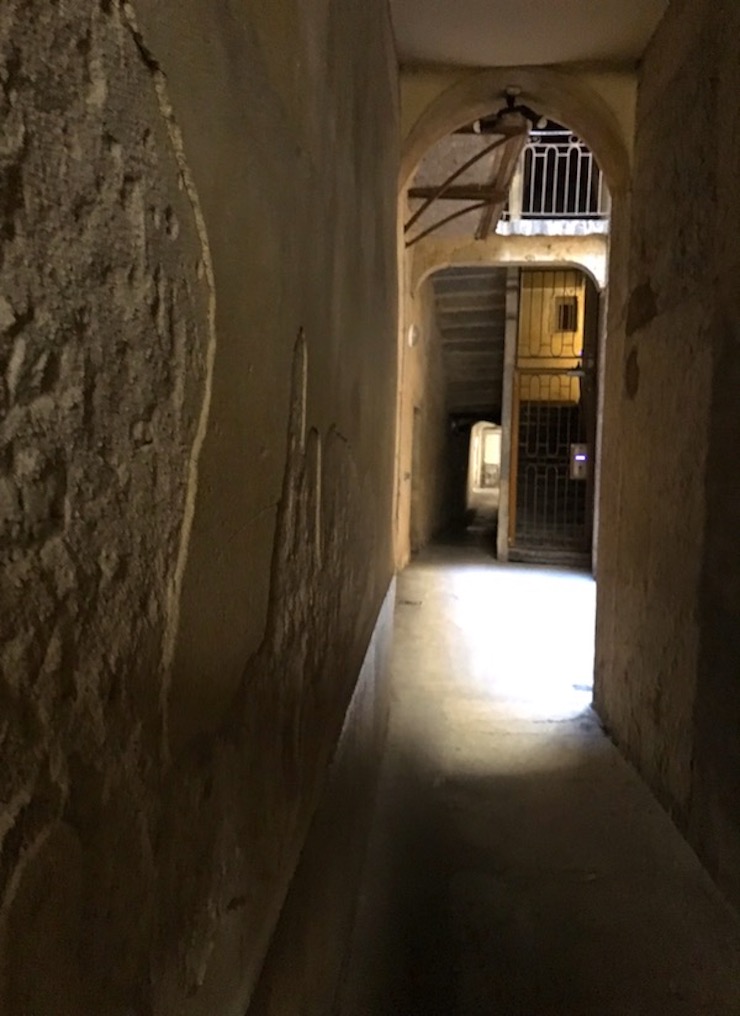
That’s the miracle of the traboules. We turn right and walk along art and craft shops, the four-star La Tour Rose, where Molière played. We arrive at Place Neuve Saint-Jean, saturated with restaurant terraces. At the corner of the square and Rue du Boeuf, notice the wooden statue of an ox on the corner of the wall. You will see the same thing later at Place de la Baleine. We take this opportunity to recommend Thierry’s tour of Old Lyon in his travel journal, where he speaks and photographs his hometown and all these streets very well.
Maison du Crible, Tour Rose, rue du Bœuf
Access: 16 rue du Bœuf
There is a very pretty courtyard with a sumptuous rose tower, with an emotional cylinder shape. It has four floors and is pierced with beautiful openings. It was built in the 16th century. Doesn’t it look a little like the pink and round tower of Part-Dieu (Tour de la Part-Dieu) that the Lyonnais nickname “the pencil”? Admire the beautiful doors.
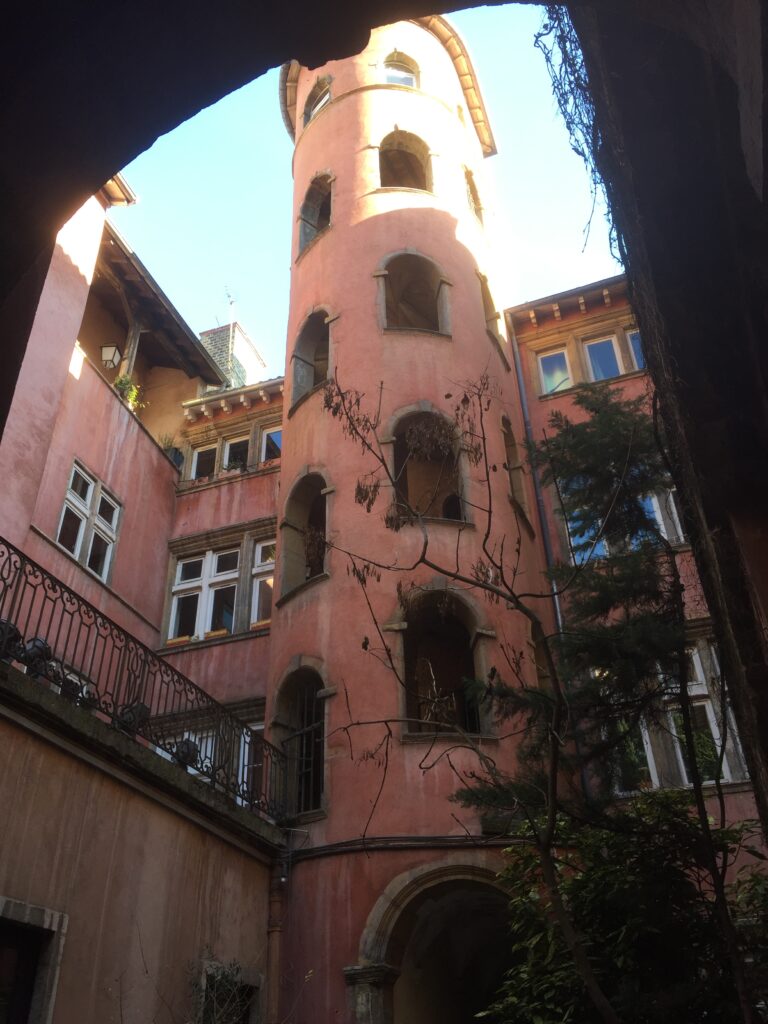
Place Neuve Saint-Jean, Palais de Justice
Come back to Place Neuve Saint-Jean. In the middle, there is a remarkable open courtyard with visible stairs. It looks like Rear Window by Hitchcock.
At the corner, there is the Palais de Justice bakery. There is often a line. It offers one of Lyon’s specialties, praline brioches. Be careful not to break your teeth!
The huge building opposite the bakery is the former courthouse. The Lyonnais call it “Les 24 colonnes” because of the Corinthian columns that decorate its facade facing the Saône. They correspond to the hours of the day. It was designed by Bathard, whose son designed the halles de Paris. In the building that preceded this one, hundreds of people were tried during the Terror, then guillotined in Place des Terreaux. The Court of Appeal and the Assize Court of the Rhône still sit here. The palace has its own prison for long trials. Maurras was tried there in 1945 and Klaus Barbie in 1987.
Traboule rue Saint-Jean to rue des Trois-Maries
Continue north on rue Saint-Jean, in descending order of street numbers. At 27 rue Saint-Jean, there is a new traboule entrance.
We come out at 6 rue des Trois Maries after two ochre courtyards and Italian galleries. A boomerang-shaped street with a visible curve. One of the most characteristic of the Vieux Lyon. You feel like you’re in the 16th century. Turn left towards Place de la Baleine. Beautiful cobblestones.
Place de la Baleine
At the corner of the very pretty Place de la Baleine and the street of the same name, we find the carved panel mentioned earlier representing a whale. It can be nice to have a drink on the terrace here in the summer, in the coolness. In the winter, there are often fire breathers. Imagine yourself here, in the Middle Ages, during one of the four major annual fairs that allowed Lyon to enter a new economic expansion, confirmed at the Renaissance by the installation of Florentine bankers who arrived in the wake of Catherine de’ Medici. They built many of the beautiful hotels that still exist today.
Traboule from Place du Gouvernement to Quai Romain Rolland
Access: 2, Place du Gouvernement
Continue down Rue Saint-Jean until you reach Place du Gouvernement. At number 2, a traboule begins with stairs leading to a beautiful courtyard. It is located above what was once the stables of the Hôtel de Saint-Christophe.
Beautiful building. It may seem almost too much due to the recent rehabilitation, but it should probably be imagined as such at its construction in the 15th century.
If you continue through the traboule, you will end up at 10 Quai Romain Rolland.
Let’s return to Rue Saint-Jean.
Gadagne Hotel and Museums
Access: 1, Place du Petit Collège
The Gadagne merchant-bankers were immensely wealthy. Simon fled Florence for Turin and then Lyon upon the return of Cosimo de’ Medici. His son, Thomas I, also succeeded in business and integrated into Lyon’s political life. His nephew, Thomas II, inherited from him, became even richer, and was elected échevin in 1537. The following year, he rented this private mansion built by the Pierrevive brothers, merchants from Piedmont. His sons Guillaume and Thomas III became its owners between 1545 and 1581. Rivals, the brothers lived at opposite ends of the hotel, where they nonetheless jointly organized sumptuous parties. In the 18th century, the building became a housing complex and was purchased by the city in 1902 and classified as a historic monument in 1920. It then housed the city’s historical museum. It was completely renovated from 1998 to 2008. The result is stunningly beautiful. The vast courtyard alone is a jewel. It contains two museums and elevated gardens.
Museum of the History of Lyon
Thirty rooms retrace the history of Lyon from Antiquity.
Its remarkable documentation center is accessible by appointment. It notably preserves manuscripts of Guignol plays (Guignol is a major puppet in the French repertoire of puppet shows).
Museum of Puppetry Arts
Organized around Guignol, it exhibits puppets in nine rooms. Paul Fournel photo Sophie Bassouls Paul Fournel © Sophie Bassouls/P.O.L
Regarding this, read our joint portrait of Laurent Mouguet, the father of Guignol theater, and Paul Fournel, the author of “Faire Guignol”.
High garden of Gadagne museum, a romantic place
Accessible without museum tickets, take the elevator to the 4th floor. You find yourself in the sky. Small terrace tables. Silence. A lawn and roses. One of the most romantic places in Lyon. You can have a drink, eat a light meal.
Place du Change, Soufflot’s spirit
Arriving at Place du Change. This is where you changed your currency before leaving the Kingdom of France. This square is often very lively with live performances. It is one of the entry points to Saint-Jean.
Temple of Change, by Soufflot
The Temple of Change, revamped by Soufflot in 1748, a famous architect, has been a Protestant place of worship since 1803. Soufflot, inspired by Andrea Palladio, who himself was inspired by the facades of Roman temples, gave it a remarkable facade, which is classified. Two clocks crown it, according to Soufflot’s wish, who had imagined an “ideal” clock marking days, months, and years. In 1999, for the turn of the millennium, his wish was fulfilled on the left of the building, in place of a clock that disappeared during the Revolution.
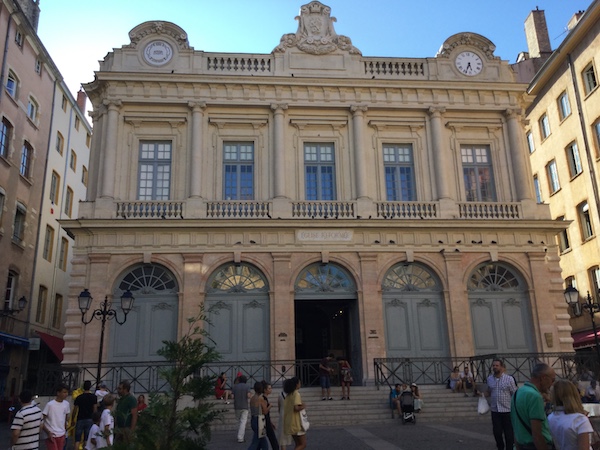
Maison Thomassin, place du Change
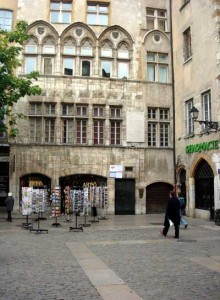
Another beautiful facade is the Gothic one of Maison Thomassin, built in 1493, which preserves a painted ceiling from the first house built in 1298 on its first floor.
Go up Rue de la Loge to the right of the Palais du Change, and at the top, take Rue de la Juiverie.
Rue Juiverie
Before entering the street, you can climb the first steps of Montée du Change to discover the Renaissance staircase of Maison Henri IV.
Almost all the facades on the street are interesting: mullioned windows, true or fake gargoyles added by the inhabitants. Several theater troop workshops.
A clock restorer at No. 20, L’Horloger de Saint-Paul, as in Bertrand Tavernier’s film, shot in this neighborhood. A beautiful sculpture workshop at No. 15.
La Galerie Philibert Delorme
Finally, at n°8 Rue Juiverie, one of the MUST-SEE places on our visit: the Galerie Philibert Delorme. A plaque in the courtyard explains its construction by the young architect returning from Italy in the early 16th century. A marvel of lightness and symbolism that unites two houses.
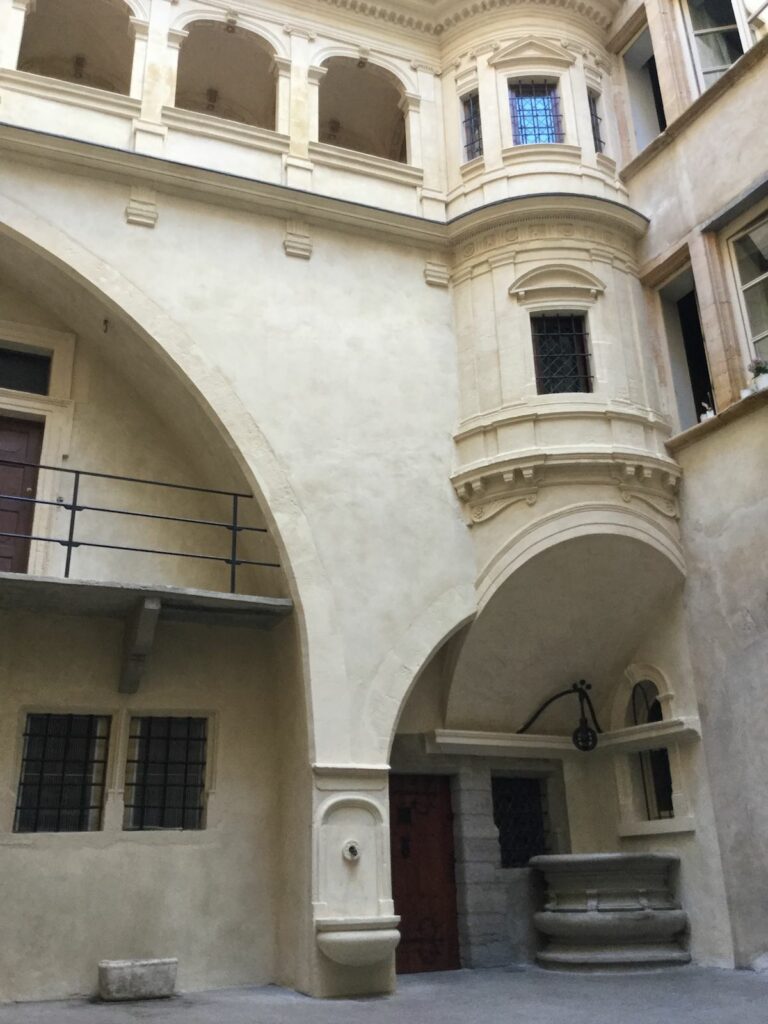
Place Saint-Paul
We arrive at Place Saint-Paul, the center of this neighborhood which, along with Saint-Georges and Saint-Jean, makes up Old Lyon. We continue to the beautifully restored Saint-Paul church, inside and out. It is adjacent to a quiet square, away from the tourist bustle of Saint-Jean, Place Gerson, with a cafe-theater characteristic of Old Lyon town and the spirit of cafe-theaters at their start in the 1970s on the slopes of Croix-Rousse.
Following your tour
You can leisurely retrace your steps to the cathedral, enjoying the pleasure of discovering what you may have missed.
You can also continue with a visit to the painted walls (this tour will soon on line), taking the Saint Vincent footbridge towards the Lyonnais fresco. This itinerary will bring you back to Place du Change, towards the wall of the Cour des Loges.
Do you want a guide in Old Lyon town?
Enter your request here:
Have a good tour in Old Lyon town!

